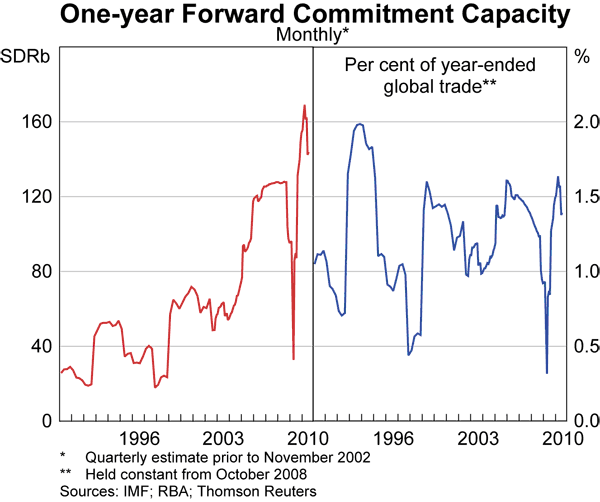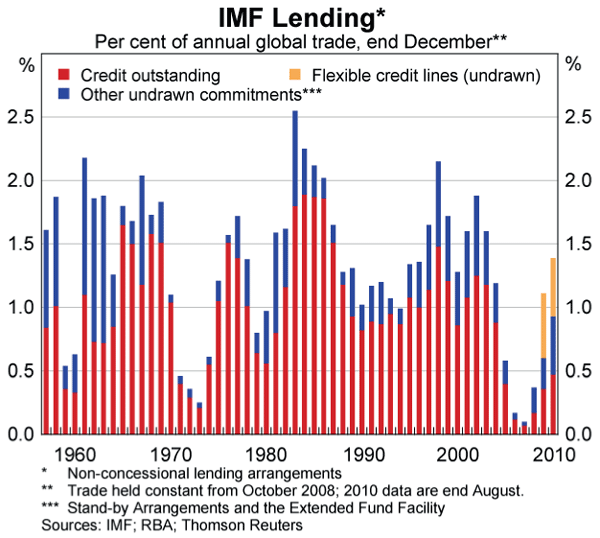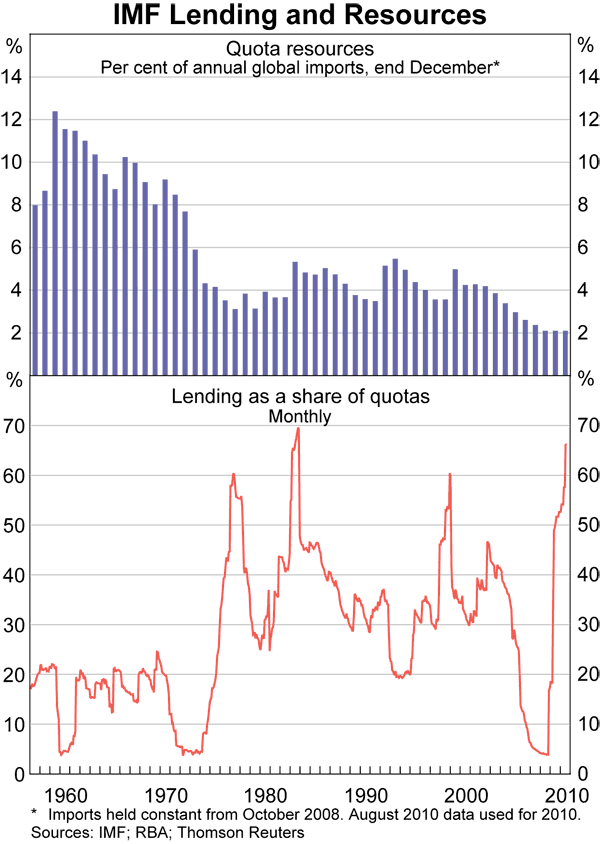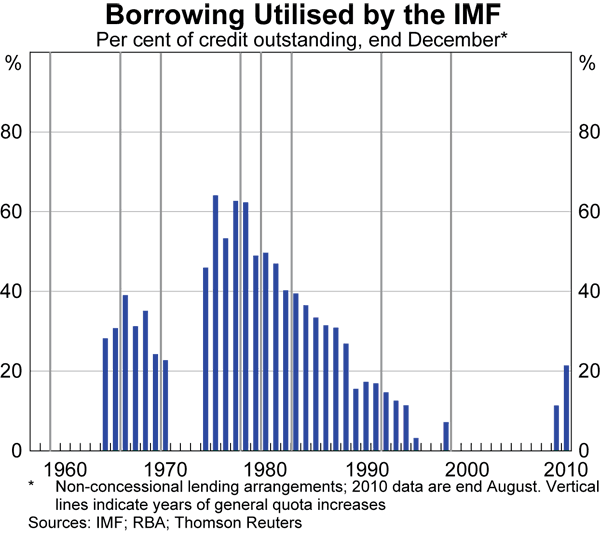Bulletin – September 2010 The Impact of the Financial Crisis on IMF Finances
- Download the article 157KB
Abstract
The global financial crisis has led to increased lending by the International Monetary Fund (IMF) to member countries. With IMF resources low by historical standards before the crisis, the IMF has funded this increase in lending partly by borrowing from member countries; this is the first time borrowing has been used since 1998. Further work to enhance the IMF's lending facilities and review the IMF's available resources is underway.
The IMF's Lending Capacity
A primaryrole of the IMF is to provide temporary financing to member countries with a balance of payments need. Financing is provided from the IMF's own resources, which include its members' capital subscriptions (known as quotas) as well as borrowing. A key indication of the IMF's ability to provide new lending to its members is the One-year Forward Commitment Capacity (FCC), a measure of its resources not already disbursed or committed. Immediately prior to the financial crisis, the FCC stood at SDR125 billion, around double that in the early 2000s (Graph 1).[1] While in absolute terms this was a record high, as a share of global trade it was no higher than a decade earlier.[2]

Following the intensification of the crisis in late 2008, the use of IMF facilities rose sharply, with the FCC reaching a low of SDR33 billion in May 2009. The decline in the FCC turned attention to the IMF's capacity to make further commitments and the IMF subsequently supplemented its resources through borrowing from its members. As a result, the IMF's available resources as a share of international trade returned to a relatively high level. The remainder of this article discusses the evolution of IMF finances during the crisis, highlighting changes in the form of financial assistance and the types of resources used.
IMF Lending
In the years leading up to the financial crisis, most of the IMF's non-concessional lending was conducted through Stand-by Arrangements (SBAs) and the Extended Fund Facility (EFF). SBAs are the IMF's core lending facility; they are available to all member countries with loan tranches disbursed provided financial and other policy conditions are met. EFFs are designed for members undertaking structural reforms; they typically have longer disbursement and repayment periods than SBAs. While members' borrowings under SBAs and EFFs normally have limits based on their quotas, these limits may be waived if deemed necessary and justifiable by the Executive Board. This is known as ‘exceptional access’.
In March 2009, a new facility – known as the Flexible Credit Line (FCL) – was established as part of a series of reforms designed to enhance the effectiveness of IMF financial assistance.[3] The facility is designed to be used predominantly as a precautionary line of credit by countries that are considered to have strong economic fundamentals and a track record of good economic policy (unlike SBAs which are available to all members). Moreover, lending is not conditional and is not subject to the usual access limits.
Prior to the collapse of Lehman Brothers in September 2008, total IMF lending (credit outstanding plus undrawn amounts from already approved arrangements) stood at less than SDR9 billion, its lowest level since 1975. By August 2010, it had reached SDR144 billion, the largest amount ever committed by the IMF (although, as a share of trade, the amount committed was not particularly high by historical standards; Graph 2).

SBAs make up the largest share of outstanding arrangements. The largest SBAs approved during the crisis (all with exceptional access) were for Ukraine with SDR11 billion (802 per cent of quota), Romania with SDR11.4 billion (1,111 per cent of quota) and Greece with SDR26.4 billion (3,212 per cent of quota). Greece's SBA represents the largest arrangement (as a share of quota) in the history of the IMF, with Korea's arrangement in 1997 the previous largest at 1,938 per cent of quota.
The use of FCLs has significantly increased the IMF's commitments. Mexico, Poland and Colombia had FCLs approved in April and May 2009 totalling SDR52 billion. Each FCL was initially active for one year and all three countries have subsequently renewed their FCLs for another year (although Colombia's renewed FCL was smaller than its original facility). Consistent with the precautionary objective of the FCLs, no drawings have been made. As a result, IMF credit outstanding is now just 0.47 per cent of global trade, less than half the historical average of 0.97 per cent.
IMF Resources
Members' quotas are the IMF's main financial resource; they are paid in members' own currencies and in reserve assets (such as SDRs or any of the four currencies that determine the value of the SDR). The size of quota resources is reviewed on a regular basis (typically every five years) to ensure the IMF's resources keep pace with potential balance of payments needs. At the previous two general quota reviews (2003 and 2008), the Executive Board determined that the IMF's available resources remained adequate. However, with global trade expanding since the last general increase in 1999, quotas have fallen to historic lows as a share of trade (Graph 3). Moreover, despite lending not being particularly large by historical standards (relative to global trade), lending as a share of quotas has risen to its highest level since the early 1980s.

The IMF's quota resources can be supplemented by borrowing arrangements, as occurred in 2009. Previously, the IMF relied on borrowed resources most heavily following the oil price shocks of the 1970s, financing over 60 per cent of IMF credit outstanding at that time (Graph 4). Historically, periods of strong borrowing by the IMF have been followed by general quota increases, thereby ensuring quotas remained the IMF's main source of funding.
Prior to the recent financial crisis, the IMF last used borrowed resources to fund non-concessional financial assistance in 1998, during the Asian financial crisis, with the borrowings repaid following the general quota increase in 1999. Borrowing in 1998 occurred through activation of two multilateral borrowing arrangements – the General Arrangements to Borrow (GAB) and the New Arrangements to Borrow (NAB).

The GAB has been in place since 1962 (but was significantly reformed in 1983). It allows the IMF to borrow up to SDR17 billion from participating countries following activation. The NAB was established in late 1998 reflecting concerns following the Mexican financial crisis in 1994 that more resources might be needed to respond to future financial crises. While the NAB potentially gives the IMF access to SDR34 billion in borrowed resources, the GAB is to be used only in limited circumstances and the maximum amount the IMF is allowed to borrow under the GAB and NAB combined is SDR34 billion.
Although the IMF still has the ability to activate SDR34 billion under the GAB and NAB (0.3 per cent of global trade in 2008), the sharp fall in available IMF resources from late 2008 led to a commitment from the G‑20 to expand the NAB and increase its flexibility. Following this, the IMF Executive Board adopted a proposal in April 2010 to expand the NAB to SDR367.5 billion, although the expansion is yet to be ratified by a sufficient number of NAB participants to make it effective.[4] Australia has ratified its expanded NAB commitment of SDR4.37 billion.
Given the time needed for the expanded NAB to become operational, the G-20 also committed to immediately increase the resources available to the IMF, with the intention of later incorporating these resources into the expanded NAB. This increase in IMF resources occurred through bilateral borrowing agreements between the IMF and some of its members; there are currently 19 bilateral agreements activated, worth approximately SDR172 billion (1.7 per cent of global trade). Consistent with the majority of IMF lending commitments remaining undrawn, most of the credit available under these bilateral agreements remains unutilised: only around SDR10 billion (21 per cent of IMF credit outstanding) has been drawn down. With the majority of credit available through these bilateral agreements still available for new IMF lending, the FCC is currently around SDR144 billion, significantly higher than the SDR33 billion available prior to these agreements becoming operational. Neither the GAB nor the NAB was activated during the recent financial crisis.
Going Forward
Although borrowing agreements boosted the IMF's resources during the crisis, the International Monetary and Financial Committee (the IMFC, a committee that advises the IMF on the direction of its work) has emphasised that quotas should remain the IMF's main financial resource and has pledged to complete the next general quota review before January 2011 (two years ahead of schedule). G-20 Leaders have called for full ratification of the expanded NAB by the time of the Finance Ministers' and Central Bank Governors' meeting in October 2010.
The general review of IMF quotas and the NAB ratification process are occurring against a background of ongoing work by the IMF to further enhance its lending facilities and modernise its governance. With respect to lending, the discussions thus far have led to an increase in the flexibility of the IMF's FCL and the creation of a new precautionary facility, which together are part of the IMF's efforts to enhance its crisis prevention ‘toolkit’. As a part of ongoing work to enhance the governance of the IMF, the G-20 have committed to increasing the voting power of emerging market and developing countries in the IMF, given their strong growth and increasing weight in the global economy. This is to be achieved by increasing these countries' shares of total quotas.
Footnotes
The author is from the International Department. [*]
The Special Drawing Right (SDR) is a reserve asset, constructed by the IMF. It is currently valued as a weighted average of the US dollar, euro, yen and sterling. [1]
Because IMF financial assistance is provided for balance of payments needs, and potential balance of payments needs increase as economies become more open, global trade (as a measure of openness) is used here to standardise IMF lending and resource data through time. Since the fall in trade following the intensification of the crisis in late 2008 did not reflect a reduction in members' potential balance of payments needs, year-ended trade flows are held constant from their peak in October 2008. [2]
For a discussion of these reforms and IMF initiatives to bolster liquidity, see Doherty (2009). [3]
The number of NAB participants will increase from 26 to 39 members. While a sufficient number of the new participants have ratified their NAB commitments, this is not true of the existing participants. [4]
References
Doherty E (2009), ‘IMF Initiatives to Bolster Funding and Liquidity’, RBA Bulletin, November, pp 7–10.
G-20 (2010), ‘The G-20 Toronto Summit Declaration’, Toronto G-20 Leaders' Summit, June. Available at <http://www.g20.org/Documents/g20_declaration_en.pdf>.
IMF (2010), ‘IMF Executive Board Approves Major Expansion of Fund's Borrowing Arrangements to Boost Resources for Crisis Resolution’, Press Release No 10/145. Available at <http://www.imf.org/external/np/sec/pr/2010/pr10145.htm>.
International Monetary and Financial Committee (2010), ‘Communiqué of the Twenty-first Meeting of the International Monetary and Financial Committee of the Board of Governors of the International Monetary Fund’, April. Available at <http://www.imf.org/external/np/sec/pr/2010/pr10166.htm>.